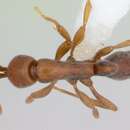en
names in breadcrumbs


A series of Probolomyrmex from Guinea, originally housed in the Santschi collection but subsequently distributed, has been mentioned several times in the literature under the name filiformis Mayr , following Santschi (1914). I have retrieved three specimens of the original seven in this series and find them to be representative of a new species , here described.
Holotype worker
HL, 0.61 mm.; HW, 0.41 mm.; SL, 0.38 mm.; CI, 67; SI, 93; WL, 800 mm.; PW, 0.30 mm.; dorsal petiole width, 017 mm.; petiolar node index, 57; petiole height, 0.31 mm.; petiolar node length, 0 - 25 mm.; lateral petiolar index, 84. General features are shown in the figures. Close to P. filiformis , but differing from it in the following characters: (1) Smaller size, with relatively broad head, short scapes, and narrow, shorter petiolar node - as indicated in the above dimensions. (2) Punctural element of sculpturation more distinct (shagreening developed on all body and appendage surfaces, as in filiformis ). Head capsule with moderately distinct superficial punctures, about 0 005 mm. in diameter, separated by distances about equal to their average diameter; those on sides and postgenal areas most distinct. Puncturation of entire pronotum and remaining mesosomal dorsum similar to frons; punctures of mes- and metepisterna larger and more distinct. Petiole and first 2 segments of gaster with larger shallow punctures, about 0.01 mm. in diameter, separated by distances averaging about half this value. (3) Concavity of declivitous propodeal face, viewed from above, about onequarter as deep as distance separating dorsal points of propodeal lamellae. (4) Subpetiolar process lacking an acute posteroventral tooth. When viewed from above, no trace of a median emargination of the posterior flange of the node.
P. guineensis resembles filiformis in all other respects, apart from slightly paler coloration. The three apical maxillary and the terminal labial palpal segments are proportioned as in P. angusticeps .
Paratype workers
Two paratype workers agree with the holotype in all essential characters, including details of the measurements and indices.
Holotype [[ worker ]] and 2 [[ worker ]] paratypes, Guinea: Nigorie, Kakoulima (Silvestri). The holotype is deposited in the Naturhistorisches Museum, Basel, paratypes in the British Museum (Nat. Hist.) and the Museum d'Histoire Naturelle, Geneva. There are differences in the original labels on these specimens. That of the holotype reads: Nigorie, Kakoulima (Silvestri); the Geneva Museum specimen has: Kakoulima 12 Ag. 1912; and the British Museum one has: French Guinea - d. F. Santschi - G. A. (presumably G. Arnold) - 1914.